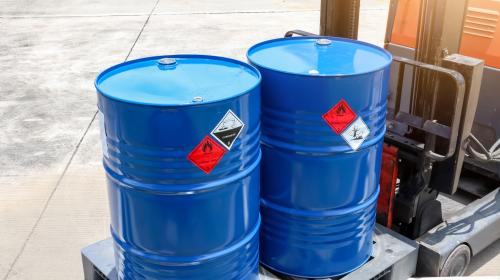Visit a retail store, and you’ll likely see the cleaning aisle is separate from the health aisle. The beauty aisle might be around another corner. But from an environmental regulatory standpoint, the products in these aisles share many similarities. Many retail consumer products or products used in health care facilities should be handled as hazardous waste if they are returned, recalled, damaged, spilled, expired or mix with other products. Improper hazardous waste disposal will eventually result in a generator being fined by local, state and federal agencies if it violates RCRA regulations. Pouring hazardous cosmetics down the drain or simply throwing them in the trash can lead to your business’s tarnished reputation and pose a threat to employee health and your bottom line.
How are cosmetics defined and regulated?
The Environmental Protection Agency (EPA) lumps cosmetics together with pharmaceuticals under the label “pharmaceuticals and personal care products” (PPCPs). They define PPCPs as, “any product used by individuals for personal health or cosmetic reasons or used by agribusiness to enhance growth or health of livestock,” which includes “a diverse collection of thousands of chemical substances, including prescription and over-the-counter therapeutic drugs, veterinary drugs, fragrances, lotions, and cosmetics.” In this article, we will address cosmetics specifically (keep an eye on our blog for a future post concerning pharmaceuticals). Regulations for generators disposing of cosmetics concern multiple agencies including the EPA, state and local agencies, and sometimes local Publicly Owned Treatment Works (POTWs). These agencies also put limits on the amount of volatile organic compounds (VOCs) contained in certain products sold at retail stores, including some beauty products like hair spray, nail polish remover and shaving cream. Health and beauty products that may be regulated as hazardous waste include:
- Aftershaves and fragrances
- Hairspray and hair products
- Shampoos and soaps
- Aerosol deodorant
- Nail polish and nail polish remover
- Hair dyes
- Hair removal creams
- Suntan lotion
While proper management and definitions for cosmetics and beauty products aren’t always clear, the EPA has labeled them, “Contaminates of Emerging Concern.” Without having an accurate understanding of the hazardous waste your company generates, your business is vulnerable to potential fines. To avoid this, pharmaceutical preparations, biotechnology, health care facilities and retailers – including small businesses like nail and hair salons – often work with consultants like the experts at Enviro-Safe Resource Recovery to ensure that they correctly identify and properly manage all products that could be hazardous wastes.
Consequences of improper hazardous waste disposal.
According to the EPA and Wisconsin DNR, the main environmental problem with improperly disposing of cosmetics is that they will end up in sewage systems, which are not equipped to remove PPCPs from human waste water, groundwater, streams, lakes, rivers and oceans. Once PPCPs enter the water, they typically stay in the water and slowly change ecosystems. Many PPCPs act as endocrine disruptors (EDCs), which are compounds that, “alter the normal functions of hormones resulting in a variety of health effects.” Ultimately, a generator’s irresponsibility with their waste may take a damaging and permanent toll on the environment.
How should generators responsibly deal with cosmetics?
Of course, there are many ways generators can easily avoid common violations of RCRA regulations. Check out our two-part post about the top 8 most common RCRA violations and ways to avoid them, including tips on employee training, proper transportation and storage, and more. Being aware of which cosmetic hazardous wastes your company is generating will also help you understand which products are subject to reduced requirement under the rules for ORM-D “consumer commodities.” Examples of products that may be hazardous materials and eligible for such reduced requirements include rubbing alcohol, aftershave lotion, hair spray and perfumes. These products are still regulated and certain protocols are still required when it comes to labeling, storage and transportation, but some regulations are less strict.
Other ways generators can reduce their compliance, disposal costs and regulatory risk is by offering fewer products that may become hazardous wastes. Selling sustainable products or participating in recycling programs, like those offered at Enviro-Safe, can help your brand image while protecting human health and the environment. We can also help make compliance easier and more cost effective. Consider consulting experts at Enviro-Safe today to help you manage your hazardous waste using waste management hierarchy best practices. With over 17 years in the business, we can help you understand which regulations you may be subject to based on your specific waste, and ultimately help you reduce your liability.



